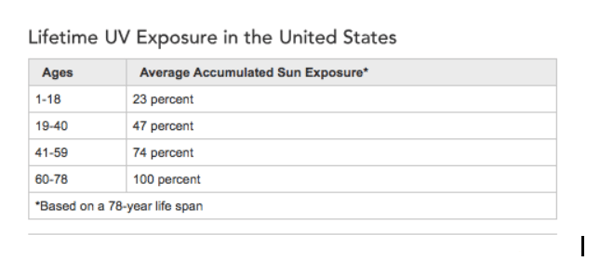Skin cancer is the most common of all cancers. But with early detection, it is also the easiest to cure.
An estimated 90 percent of skin aging is caused by sun exposure and, according to the Skin Cancer Foundation, sun damage to skin is cumulative, based on this chart from the foundation.

Thankfully, there are ways older adults can reduce their risk of skin cancer. The next time you head outside to enjoy the sun, keep these things in mind:
Your skin type influences your skin cancer risk: The Fitzpatrick skin type test classifies your skin type based on how much pigment your skin has. This information can help you determine how your skin will react to sun exposure and determine your risk for sun damage or skin cancer. The test includes six skin types. Though you may not exactly fit a type based on the descriptors, try and choose the one that best describes your appearance and sun reactions. Take the Fitzpatrick skin type test here.
Your car could play a large role in your sun exposure: When you think of sun exposure, you probably think of spending a day at the beach or gardening, but for many of us, the vast amount of sun exposure we receive happens when we’re in the car.
Interestingly, dermatologists have found that many people have signs of skin aging—wrinkles, dark spots—more on the left sides of their faces. This has to do with the UV rays coming through the car window on the driver’s side, according to research cited by the Skin Cancer Foundation.
Protect yourself by applying a broad-spectrum sunscreen with an SPF of 15 or higher to your face, arms, neck and hands about 30 minutes before you drive. Long sleeves, sunglasses and brimmed hats also offer protection, as do tinted car windows.
Skin cancer is the most common of all cancers: But with early detection, it is also the easiest to cure. Self-exams are one of the easiest ways to fight against skin cancer, according to the Skin Cancer Foundation. If you perform these exams regularly—about once a month, they can help you spot changes in your skin.
Look for these changes in your skin:
- A growth that increases in size and appears translucent, pearly, tan, brown or black
- Any brown spot (like a mole, or birthmark) that changes color, increases in size or thickness, changes texture, has an irregular outline or is bigger than the size of a pencil eraser.
- A spot or sore that continues to itch, bleed or hurt and/or does not heal within three weeks
If you spot any skin changes with the above signs or any skin changes that concern you, see your doctor as soon as possible.
You can prevent skin cancer: Despite its prevalence, skin cancer can be prevented with a few simple steps. In addition to performing regular skin examinations, you should:
- Seek shade if you’re outdoors between 10 a.m. and 4 p.m.
- Prevent sunburn
- Avoid tanning and using indoor tanning booths
- Use clothing to cover up from sun exposure and use broad spectrum sunscreen of at least SPF 15 or higher every day.
- Apply sunscreen at least 30 minutes before you go outside
- See your doctor yearly for a professional skin exam










